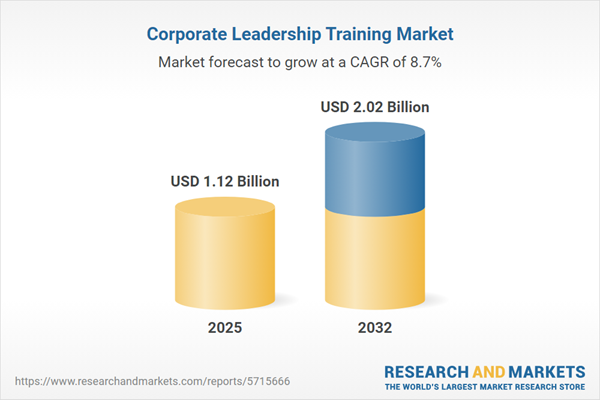Speak directly to the analyst to clarify any post sales queries you may have.
The executive leadership training market is evolving rapidly, driven by complex global business challenges and a growing demand for adaptive, data-driven learning solutions. As organizations seek resilient leaders who can navigate uncertainty and accelerate growth, investing in robust leadership development strategies has become essential for sustained success.
Market Snapshot: Corporate Leadership Training Market Size and Growth
The Corporate Leadership Training Market grew from USD 1.03 billion in 2024 to USD 1.12 billion in 2025. With a projected CAGR of 8.67%, market value is expected to approach USD 2.02 billion by 2032. This significant expansion is driven by the rising importance of executive leadership development across global enterprises, as businesses respond to technological disruption, shifting workforce dynamics, and broader stakeholder expectations.
Scope & Segmentation of Executive Leadership Training
- Delivery Modes: Blended learning, classroom-based instruction, and online solutions, including self-paced modules and virtual classroom environments.
- Organization Sizes: Large enterprises; micro enterprises; small and medium enterprises, each with distinct priorities and integration levels.
- Industry Verticals: Banking, financial services and insurance (BFSI); healthcare; IT and telecom; manufacturing, with specialized training content adapted to sector needs.
- Training Topics: Programs for emerging leaders, executive leadership, functional skills, and middle management, tailored to develop both foundational and advanced capabilities.
- Participant Levels: Pathways for emerging managers, middle managers, and senior executives, supporting targeted leadership growth.
- Deployment Modes: In-house training, private sessions, and public training sessions, enabling organizations to choose optimal formats based on resources and goals.
- Regional Coverage: Americas (United States, Canada, Mexico, Brazil, Argentina, Chile, Colombia, Peru); Europe, Middle East & Africa (United Kingdom, Germany, France, Russia, Italy, Spain, Netherlands, Sweden, Poland, Switzerland, United Arab Emirates, Saudi Arabia, Qatar, Turkey, Israel, South Africa, Nigeria, Egypt, Kenya); Asia-Pacific (China, India, Japan, Australia, South Korea, Indonesia, Thailand, Malaysia, Singapore, Taiwan).
- Leading Companies: Franklin Covey Co., Dale Carnegie & Associates Inc., Korn Ferry Holdings Inc., Willis Towers Watson PLC, Mercer LLC, DDI Inc., GP Strategies Corporation, Skillsoft Ltd., Center for Creative Leadership Inc., Wilson Learning Worldwide Inc.
Key Takeaways for Senior Decision-Makers
- Executive leadership development is transitioning from conventional management training to include adaptive, analytics-driven, and immersive experiences that address disruptive business environments.
- Organizations adopting modular and hybrid learning models can meet diverse learner preferences and organizational requirements more effectively.
- Integrated digital tools, such as AI-powered feedback and virtual simulations, support measurable improvements in talent retention, innovation capacity, and leadership performance.
- Programs now embed diversity, equity, and inclusion principles, with a rising focus on ethical decision making and cross-cultural competence among leaders.
- Vendor selection increasingly prioritizes regional expertise, digital infrastructure capability, and the agility to maintain program continuity amidst supply chain and geo-economic volatility.
Impact of United States Tariffs on Training Strategies
Recent U.S. tariff measures have directly influenced corporate training strategy and budget allocation, especially for companies reliant on imported materials and technology. In response, organizations are accelerating adoption of digital and cloud-based learning platforms. Flexible content delivery and innovative pricing models have emerged to contain costs and manage uncertainty. There is also a stronger preference for vendors with regional or robust online support, ensuring continuity when supply chain disruptions occur.
Methodology & Data Sources
This analysis deploys a rigorous multi-phase methodology, starting with extensive secondary research. Primary interviews with senior executives and training providers enrich the findings with direct market insights. Using multi-dimensional segmentation, the report examines trends by delivery channel, organizational scale, industry focus, and deployment models. Findings undergo expert validation to ensure relevance and reliability.
Why This Report Matters
- Enables decision makers to benchmark leadership development practices and adapt strategies for digital resilience and growth.
- Offers actionable insights for optimizing resource allocation, vendor selection, and training program design in line with global and regional complexity.
- Supports alignment between executive learning initiatives and long-term business priorities, including ESG goals and cultural transformation.
Conclusion
This report equips senior leaders with the insights to navigate evolving executive leadership training demands. By leveraging digital innovation, tailored program design, and agile budgeting, organizations can strengthen their leadership pipelines and sustain growth in a dynamic environment.
Additional Product Information:
- Purchase of this report includes 1 year online access with quarterly updates.
- This report can be updated on request. Please contact our Customer Experience team using the Ask a Question widget on our website.
Table of Contents
3. Executive Summary
4. Market Overview
7. Cumulative Impact of Artificial Intelligence 2025
Companies Mentioned
The companies profiled in this Corporate Leadership Training market report include:- Franklin Covey Co.
- Dale Carnegie & Associates, Inc.
- Korn Ferry Holdings, Inc.
- Willis Towers Watson Public Limited Company
- Mercer LLC
- DDI, Inc.
- GP Strategies Corporation
- Skillsoft Ltd.
- Center for Creative Leadership, Inc.
- Wilson Learning Worldwide, Inc.
Table Information
| Report Attribute | Details |
|---|---|
| No. of Pages | 186 |
| Published | October 2025 |
| Forecast Period | 2025 - 2032 |
| Estimated Market Value ( USD | $ 1.12 Billion |
| Forecasted Market Value ( USD | $ 2.02 Billion |
| Compound Annual Growth Rate | 8.6% |
| Regions Covered | Global |
| No. of Companies Mentioned | 11 |









